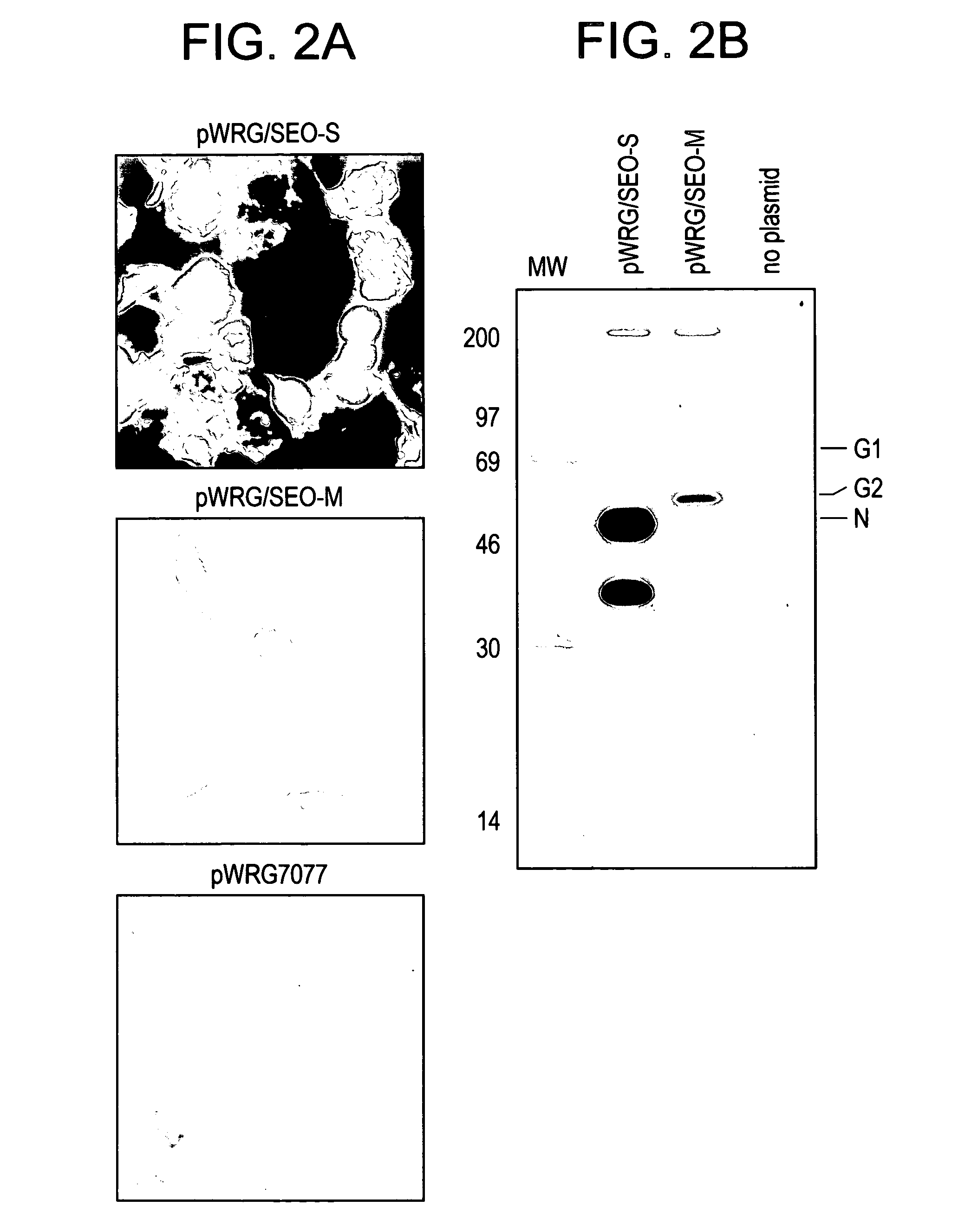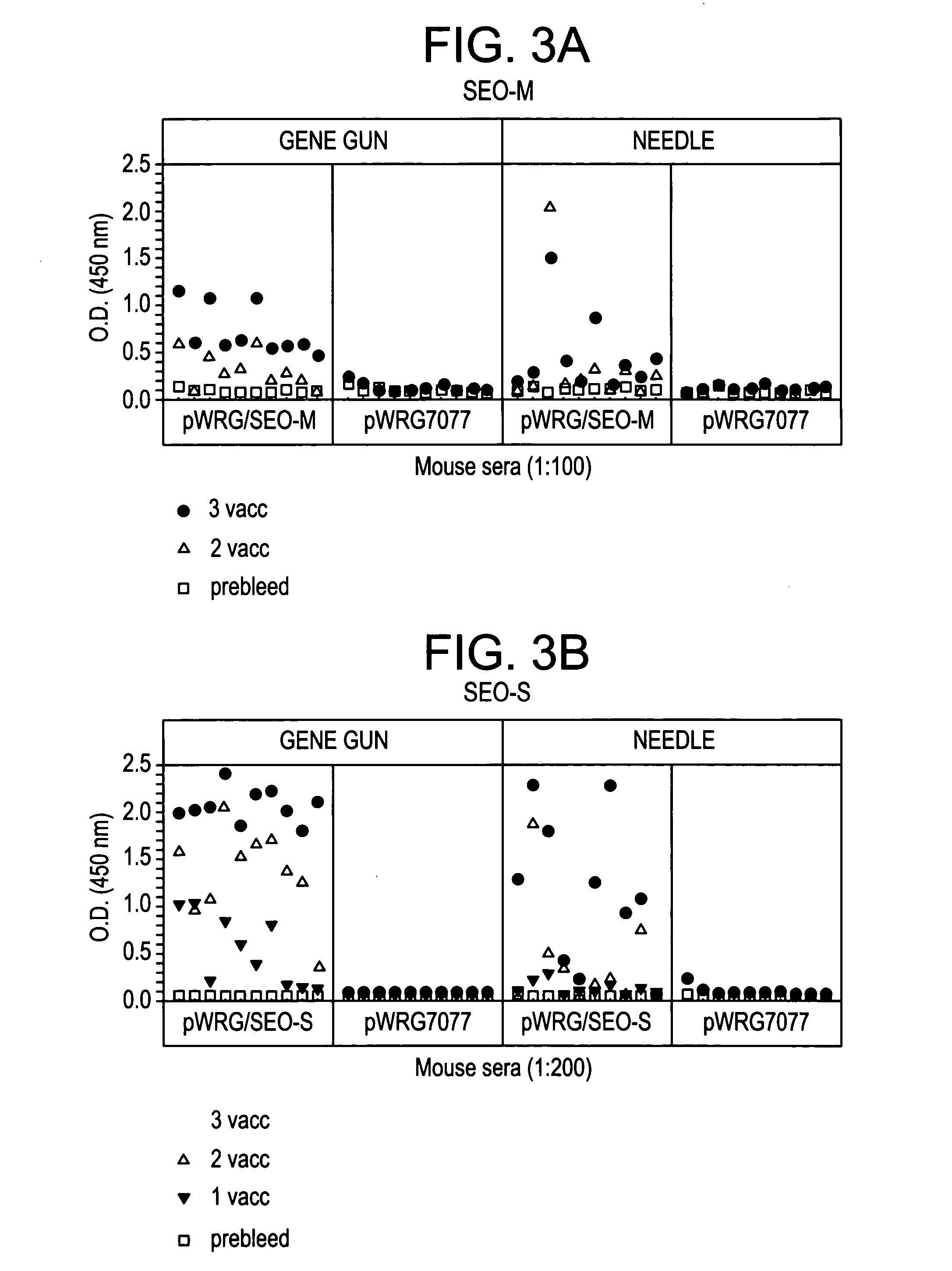Extraneous DNA sequence that facilitates hantavirus gene expression
a hantavirus and dna sequence technology, applied in the field of extraneous dna sequence that facilitates hantavirus gene expression, can solve the problems that neither the immune response against hantaviruses nor the protection against hantavirus infection have so far been demonstrated using, and achieve the effect of not painful to administer
- Summary
- Abstract
- Description
- Claims
- Application Information
AI Technical Summary
Benefits of technology
Problems solved by technology
Method used
Image
Examples
example 1
[0143]Transient Expression of Hantavirus Genes.
[0144]The cDNA representing the M (SEQ ID NO:1) or S (SEQ ID NO:2) gene segment of the SR-11 strain of SEOV was subcloned into the naked DNA expression vector pWRG7077 downstream of the cytomegalovirus immediate early promoter to yield pWRG / SEO-M (SEQ ID NO:3) and pWRG / SEO-S (SEQ ID NO:4), respectively (FIG. 1). To assess expression by the M and S constructs, these plasmids were transfected into COS cells and the expressed proteins were either immunostained or immunoprecipitated. The presence of stained cells in transfected monolayers incubated with anti-SEOV polyclonal sera indicated that SEOV reactive protein(s) were expressed from both pWRG / SEO-M and pWRG / SEO-S (FIG. 2A). Radiolabeled expression products were immunoprecipitated with anti-SEOV polyclonal antisera and analyzed by SDS-PAGE (FIG. 2B). Immunoprecipitated proteins had apparent molecular sizes expected for G1, G2, and N (80 kDa, 56 kDa, and 48 kDa)(Elliot et al. 1984, J. Ge...
example 2
[0145]Vaccination of mice with pWRG / SEO-M or pWRG / SEO-S. To determine if either the M or S construct could elicit an antibody response in mice, groups of 10 6- to 8-week-old female BALB / c mice were vaccinated with pWRG / SEO-M, pWRG / SEO-S, or negative control DNA (pWRG7077) by two different routes: inoculation of the epidermis by gene gun, or inoculation of the gastrocnemius muscle by needle injection. Mice received a priming vaccination followed by two boosts at 4 week intervals. Blood samples collected before each vaccination and 3 weeks after the final boost were screened for a SEOV-specific antibody response by ELISA. Both the M and S constructs elicited a SEOV-specific antibody response by both routes of DNA administration (FIG. 3). Most mice vaccinated with SEOV S by gene gun exhibited specific antibodies after only one vaccination, and the antibody responses increased after subsequent vaccinations (FIG. 3B). To compare the relative antibody responses, end-point ELISA titers wer...
example 3
[0148]Vaccination and challenge of hamsters. To study the protective efficacy of the naked DNA hantavirus vaccines, groups of five hamsters were vaccinated with either pWRG / SEO-M, pWRG / SEO-S, or negative control plasmid pWRG7077 by gene gun (a priming vaccination followed by two boosts at 4-week intervals) and then challenged with SEOV 6 weeks after the final boost. IFAT, ELISA, and PRNT were performed on serum samples taken before vaccination, on the day of challenge, and 4 weeks after challenge. Because there are no disease models for hantavirus in adult rodents, we evaluated whether or not our DNA vaccines could protect against infection rather than prevent disease.
[0149]IFAT and ELISA results demonstrated that before vaccination, none of the hamsters was positive for either SEOV G1-G2 or N protein (data not shown). After vaccination (prechallenge sera drawn on day of challenge), five of five hamsters vaccinated with pWRG / SEO-M developed anti-G1-G2 antibodies, and four of five ha...
PUM
| Property | Measurement | Unit |
|---|---|---|
| Volume | aaaaa | aaaaa |
| Fraction | aaaaa | aaaaa |
| Fraction | aaaaa | aaaaa |
Abstract
Description
Claims
Application Information
 Login to View More
Login to View More - R&D
- Intellectual Property
- Life Sciences
- Materials
- Tech Scout
- Unparalleled Data Quality
- Higher Quality Content
- 60% Fewer Hallucinations
Browse by: Latest US Patents, China's latest patents, Technical Efficacy Thesaurus, Application Domain, Technology Topic, Popular Technical Reports.
© 2025 PatSnap. All rights reserved.Legal|Privacy policy|Modern Slavery Act Transparency Statement|Sitemap|About US| Contact US: help@patsnap.com



